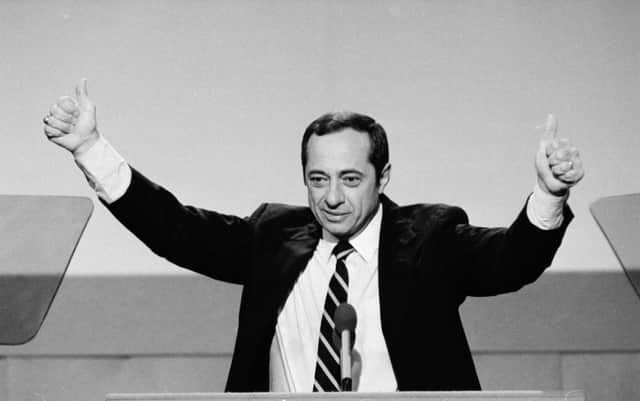‘Hamlet on the Hudson’ Mario Cuomo dies at 82


His death, from heart failure, came on the same day his son Andrew started his second term as state governor.
Cuomo loomed large in New York politics as governor from 1983 until 1994 and became nationally celebrated for his ability to weave the story of his humble upbringing with ringing calls for social justice.
Advertisement
Hide AdAdvertisement
Hide AdBut he was also known for the presidential races he stayed out of in 1988 and 1992, agonising so publicly over whether to run for the White House that he was dubbed “Hamlet on the Hudson”.
In 1991, Cuomo left a plane idling on the tarmac at the Albany airport rather than fly to New Hampshire and jump into the battle for the presidential nomination at the last minute. He left the door open for a lesser-known governor, Bill Clinton of Arkansas.
Cuomo’s last public appearance came in November, when Andrew was re-elected governor of New York. The frail-looking patriarch and his son raised their arms together in victory at the election-night celebration.
He didn’t attend his son’s second inaugural speech on Thursday because he was not well, but the current governor spoke of his father.
“He is here and he is here, and his inspiration and his legacy and his experience is what has brought this state to this point,” Andrew Cuomo said.
US president Barack Obama said yesterday that Cuomo had been “a determined champion of progressive values and an unflinching voice for tolerance, inclusiveness, fairness, dignity, and opportunity”.
Mr Obama added: “His own story taught him that as Americans, we are bound together as one people, and our country’s success rests on the success of all of us, not just a fortunate few.”
Mario Cuomo’s big political break came in 1982 when, as New York’s lieutenant governor, he won the Democratic nomination for governor in an upset over New York mayor Ed Koch. He went on to beat the Republican candidate, conservative millionaire Lewis Lehrman.
Advertisement
Hide AdAdvertisement
Hide AdIn early 1987, he was leading the polls among prospective White House contenders when he said he would not be a candidate. A more protracted dance in 1991 ended with the filing deadline for the nation’s first presidential primary 90 minutes away. Cuomo walked into a packed news conference in Albany and cited a continuing budget battle with New York’s Republicans in declining to run.
Cuomo easily won re-election for governor in 1986 and 1990. He repeatedly vetoed legislation that would have restored the death penalty in New York and closed down the Shoreham nuclear power plant on Long Island. He built 30 new prisons.
In 1993, he turned down an opportunity to be nominated by Mr Clinton for a seat on the US Supreme Court, telling the new president in a letter that “by staying active in our nation’s political process, I can continue to serve as a vigorous supporter of the good work you are doing for America and the world.”
Nineteen months later, with voters tired of him, Cuomo lost his bid for a fourth term to George Pataki, a Republican who had pledged to cut taxes and bring back the death penalty.
Cuomo grew up behind the small grocery store run by his parents in the New York district of Queens. He attended St John’s University in New York City, and, after graduating with honors in 1953, he spent a summer playing minor league baseball.
He graduated from St John’s Law School in 1956 and went into private practice.
In 1974, Cuomo made his first run for public office, losing a Democratic primary for lieutenant governor. He lost the race for mayor of New York City to Koch in 1977. During the campaign, posters that read “Vote for Cuomo, Not the Homo” mysteriously appeared in some neighborhoods. Cuomo denied any responsibility, but the bachelor Koch never forgave him.